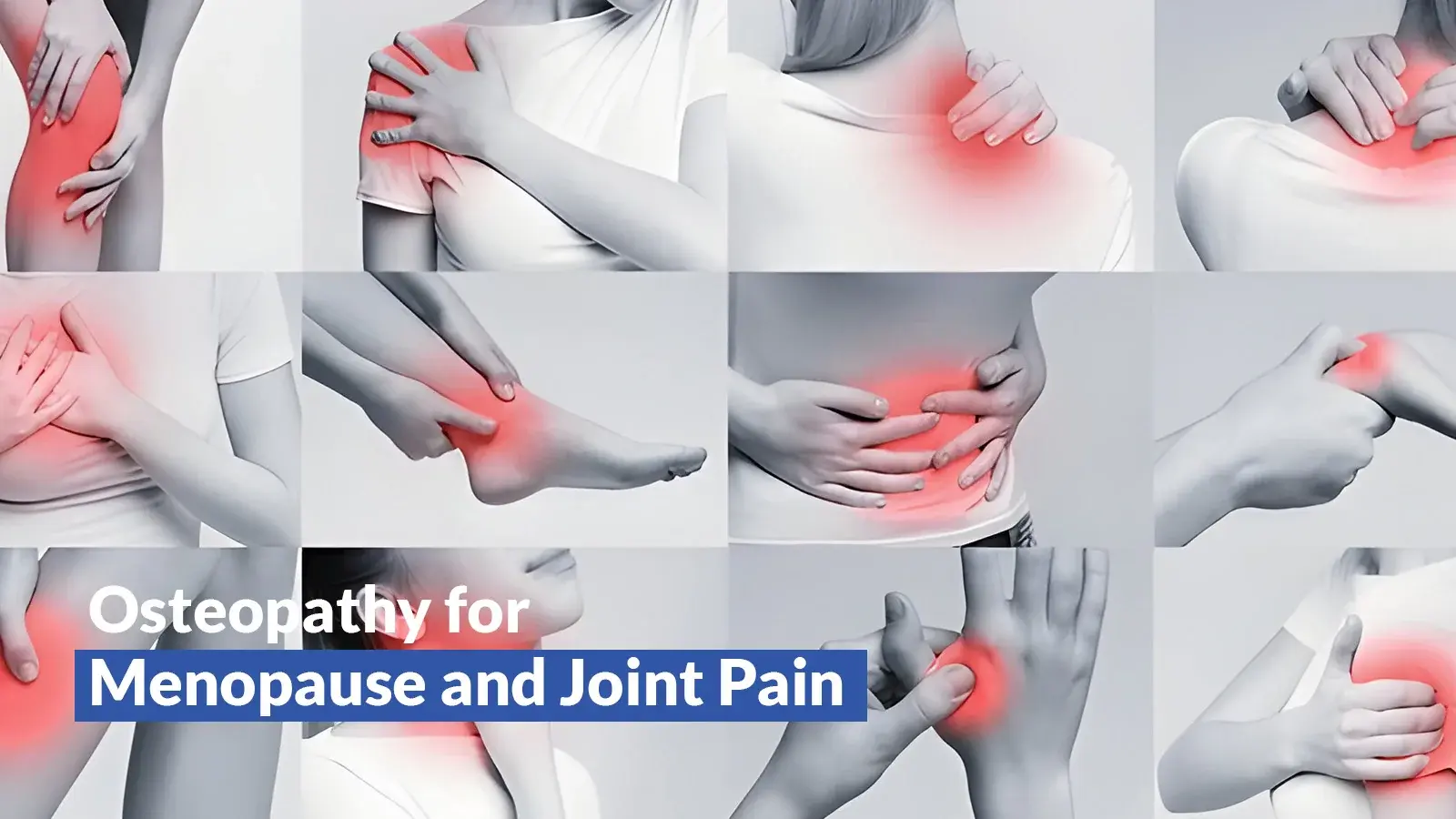You also believed “only severe menopause symptoms need treatment”? Well, it’s time to let go of this myth. Osteopathy isn’t just for those with the most intense discomfort; it provides valuable support for managing various menopausal symptoms. By focusing on the body’s natural healing abilities, osteopathy aims to improve overall well-being and address joint pain, stiffness, and other uncomfortable menopausal issues and treats them through different techniques and core exercises.
So, what exactly happens when menopause arrives? As your ovaries stop releasing eggs and your period comes to an end, your body undergoes significant changes. For many women, this transition happens naturally after 40, but sometimes, due to surgery or treatments like chemotherapy, it can happen earlier. When it occurs before 40, it’s called premature menopause.
This shift in hormones doesn’t just affect your menstrual cycle—it can also impact your joints. As estrogen levels drop, you might notice your joints feeling stiffer or even experience inflammation. This is where osteopathy comes in. Known for its gentle and holistic approach, osteopathy can help re-balance your body during menopause, easing joint pain and improving your overall mobility.
Understanding Menopause and Joint Pain
Understanding the link between menopause and joint pain starts with knowing how your hormones change. During menopause, two key hormones—cortisol and estrogen—undergo significant shifts.
Cortisol, often called the stress hormone manages stress & controls inflammation. During menopause, cortisol levels can get unbalanced, affecting how you handle stress and how your body manages inflammation. When cortisol is off, it can lead to more inflammation in your joints, causing stiffness and discomfort. That’s why many women experience joint pain during menopause as cortisol isn’t able to keep inflammation in check like it used to.
Common Menopause Symptoms
Menopause is a natural phase in a woman’s life, and it can bring about a range of challenging symptoms. Here are the most common and uncomfortable issues women face during this transition.
Hot flushes: Suddenly feeling like you’re on fire from the inside out? They can come on suddenly, causing intense heat and sweating.
Night sweats: Waking up drenched in sweat? It’s not you it’s menopause. It can be disruptive and lead to poor sleep quality.
Mood swings: Mood changes are common. One minute you’re fine, the next you’re crying or fuming.
Vaginal dryness: An under-discussed common symptom that can make intimacy uncomfortable or painful.
Joint pain: Some women find their joints creak like an old rocking chair every time they move.
Headaches: Headaches may become more frequent or severe.
Fatigue: Feeling like you could nap at any moment, even right after waking up? That’s a common one.
Weight gain: You might be putting on pounds around the midsection even though your diet hasn’t changed. Menopause might be the trigger.
Insomnia: Sleep disturbances, including difficulty falling asleep or staying asleep, affect many women.
These symptoms can be challenging and disturbing. Having said that, there are effective ways to manage them. Keep on reading to discover a non-invasive ancient practice in fighting menopause and its pesky symptoms.
How Osteopathy Can Help with Joint Pain Menopause?
“Menopause is just about hot flushes… ”
Now this needs to be addressed. While hot flushes and night sweats are very common in menopause, there’s more to the story. One of the ‘hidden’ weapons menopause strikes you with is bladder weakness. Um, how? Lower estrogen levels can make your bladder weaker and less stretchy. Plus, those muscles that hold everything in place down there? They lose some strength too. That’s why bladder leaks can happen.
Osteopathy can be a game changer during menopause. It’s not just about easing those hot flushes. Think of it as a whole-body tune-up.
Osteo treatments can help by restoring the correct fluid dynamics and improving the movement of the area’s muscles, organs and joints. By strengthening your pelvic floor muscles, osteopathy can help reduce bladder issues. It’s like giving your body’s support system a much-needed boost.
Here are some ways in which osteopathy can help in your menopause:
A Holistic Solution for Menopause Symptoms
Osteopathy helps your body learn better ways to move, which can reduce muscle tension and joint pain menopause by improving alignment and promoting efficient movement. It’s like teaching your body to work smarter, not harder, so you experience less strain and discomfort. For menopause, osteopathy is particularly effective because it addresses changes in hormone levels that can lead to joint stiffness and inflammation. By using techniques such as gentle manipulation, stretching, and soft tissue work, osteopathy can ease symptoms such as hot flushes, headaches, and general discomfort. Studies like “MENQOL” confirm that this holistic approach helps balance the body, making the transition through menopause more manageable and comfortable.
The Power of Combining Osteopathy with Pilates
Pilates is like a secret weapon during menopause—it gently strengthens your core, keeps you flexible, and supports your bones. It is great for easing joint stiffness and back pain and helps you stay toned when your hormones start shifting. Having said that, pilates isn’t just about the body; it’s a stress buster that can help you sleep better and feel more energised. With its focus on smooth movements and deep breathing, Pilates is a fantastic way to navigate menopause feeling strong and balanced.
Supporting Women Through Life’s Changes
In menopause, osteopathy manages joint pain and stiffness, supporting overall body balance. Key exercises include pelvic floor strengthening, gentle stretching, core strengthening, and deep breathing, all of which contribute to comfort and function during these stages. General practices recommended by osteopaths, such as maintaining an active lifestyle with regular physical activity, are also important to adopt. They help keep joints flexible, strengthen muscles, and improve circulation, which reduces inflammation and enhances overall well-being, making menopause symptoms more manageable.
Osteopathy: A Natural Solution for Menopause Symptoms
Osteopathy isn’t just about fixing a single problem it’s about helping your whole body feel better. Whether you’re dealing with period pain, joint stiffness, osteoarthritis, menopause and hip joint pain, or other menopause symptoms, osteopathy can help rebuild balance and improve your overall well-being naturally. For menopause, osteopathy can uproot joint pain and stiffness by improving blood flow and reducing inflammation. Osteopaths use non-invasive techniques to correct misalignments and relieve muscle tension, which can ease discomfort. Additionally, osteopathy supports overall well-being by enhancing flexibility, improving posture, and promoting relaxation.
One thing important to note here is: Osteopathy is not a replacement for hormonal replacement therapy. It can complement HRT or be used as a standalone treatment. However, Certain health conditions might make HRT unsuitable for some women, making osteopathy a more viable option.
A Personalized Approach to Menopause Relief
When you visit an osteopath for menopause-related issues, you can expect a comprehensive and personalised approach to your care. Your first session usually begins with a detailed assessment where the osteopath takes time to discuss your medical history, symptoms, and any specific concerns you have, like joint pain, stiffness, or other discomforts that might be related to menopause. Further treatment is followed by the following:
Hands-on Techniques: The treatment will typically involve less intense, hands-on techniques such as stretching, massaging, and manipulating your muscles and joints. These techniques help ease muscle tension, improve joint mobility, and promote better circulation, which reduces inflammation and relieves pain.
Advice on Exercise: Alongside the hands-on treatment, the osteopath will likely suggest specific exercises tailored to your needs. These might include pelvic floor strengthening exercises, gentle stretches, and core-strengthening routines that help maintain joint health and support your body through the changes of menopause. These exercises are key to managing stiffness and discomfort and can be done at home to complement your osteopathy sessions.
Lifestyle Recommendations: Your osteopath may also offer advice on lifestyle changes that can help manage menopause symptoms. This could include guidance on improving your posture, incorporating anti-inflammatory foods into your diet, and managing stress through techniques like deep breathing. All of these factors work together to support your overall well-being and make the transition through menopause smoother and more comfortable.
Overall, an osteopathy session for menopause and joint pain is not just about addressing immediate pain but also about empowering you with the knowledge to manage your symptoms effectively and maintain your quality of life.
How Osteopathy Can Transform Your Journey
Let’s break the menopause taboo, shall we? It’s time we talk about it openly, without whispers or embarrassment.
Here’s a fact that might surprise you: studies show that up to 50% of women experience joint pain during menopause. Yep, you’re not imagining those aches!
But here’s the good news: osteopathy isn’t just a band aid solution. It’s backed by science. Research published in the Journal of Bodywork and Movement Therapies found that osteopathic treatment significantly reduced menopausal symptoms in women. It’s like a refinement for your body. It doesn’t just mask symptoms but helps your body heal itself.
Menopause is that “change of life” where your body’s going through a major shift. Osteopathy helps it adapt more smoothly.
Ready to give it a shot? A chat with a qualified osteopath could be your first step towards a more comfortable menopause journey. Osteopath Sydney, led by Dr Phil Austin, is one of the best places to go. We offer a comfortable environment where our skilled osteopaths listen to you and support you on your journey.
Remember, every woman’s experience is unique. Sharing our stories helps us all. So, let’s keep talking, keep supporting, and keep exploring solutions like osteopathy. Your best menopausal years could be just around the corner!


